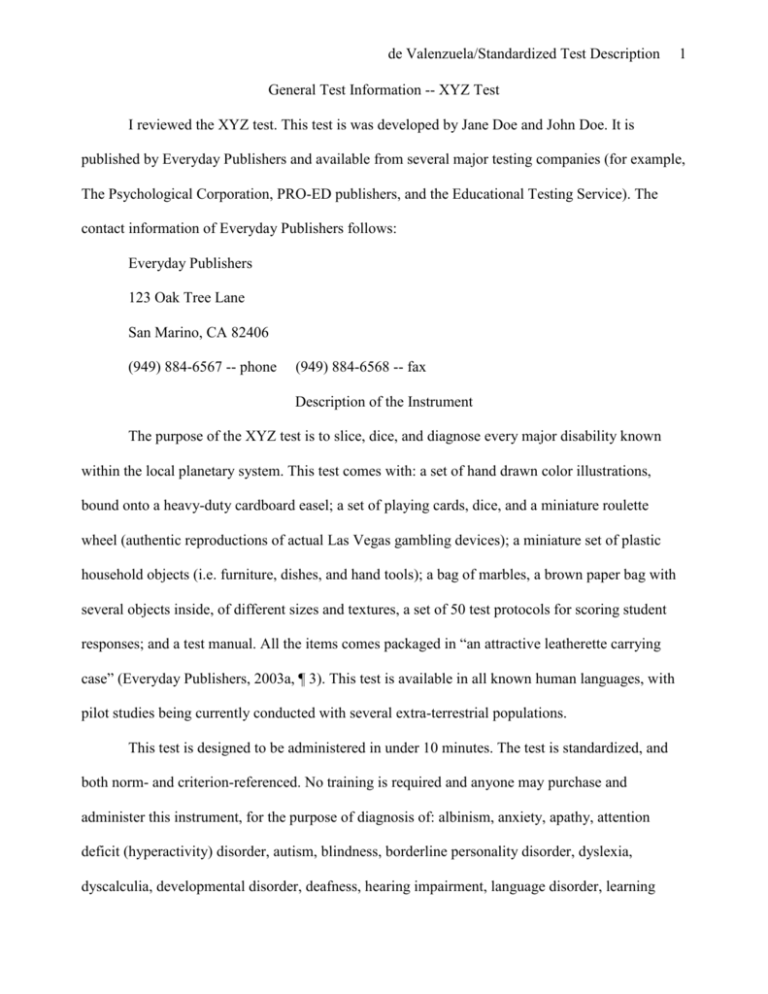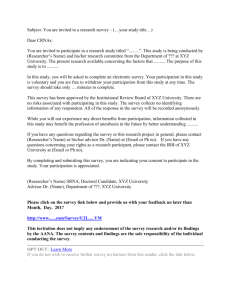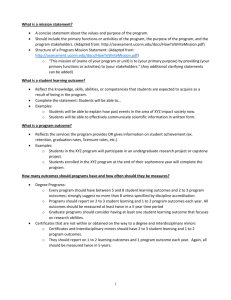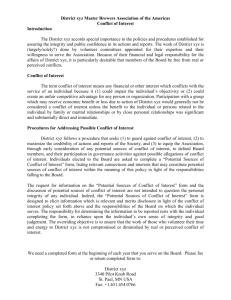General Test Information -
advertisement

de Valenzuela/Standardized Test Description 1 General Test Information -- XYZ Test I reviewed the XYZ test. This test is was developed by Jane Doe and John Doe. It is published by Everyday Publishers and available from several major testing companies (for example, The Psychological Corporation, PRO-ED publishers, and the Educational Testing Service). The contact information of Everyday Publishers follows: Everyday Publishers 123 Oak Tree Lane San Marino, CA 82406 (949) 884-6567 -- phone (949) 884-6568 -- fax Description of the Instrument The purpose of the XYZ test is to slice, dice, and diagnose every major disability known within the local planetary system. This test comes with: a set of hand drawn color illustrations, bound onto a heavy-duty cardboard easel; a set of playing cards, dice, and a miniature roulette wheel (authentic reproductions of actual Las Vegas gambling devices); a miniature set of plastic household objects (i.e. furniture, dishes, and hand tools); a bag of marbles, a brown paper bag with several objects inside, of different sizes and textures, a set of 50 test protocols for scoring student responses; and a test manual. All the items comes packaged in “an attractive leatherette carrying case” (Everyday Publishers, 2003a, ¶ 3). This test is available in all known human languages, with pilot studies being currently conducted with several extra-terrestrial populations. This test is designed to be administered in under 10 minutes. The test is standardized, and both norm- and criterion-referenced. No training is required and anyone may purchase and administer this instrument, for the purpose of diagnosis of: albinism, anxiety, apathy, attention deficit (hyperactivity) disorder, autism, blindness, borderline personality disorder, dyslexia, dyscalculia, developmental disorder, deafness, hearing impairment, language disorder, learning de Valenzuela/Standardized Test Description disabilities, mental retardation, multiple disabilities, personality disorders, phonological processing disorders, physical limitations, psychic malfunction, speech impairment, and visual impairment. The test can be administered to infants as young as two hours after birth to 91 years of age. Subtests The XYZ test has five major subtests, which can be combined to provide a number of different subscale scores. The subtests are: 1. manual dexterity 2. receptive vocabulary 3. odds calculation 4. adaptive behavior 5. imagination and tactile defensiveness Each subtest can be scored and interpreted individually, and in combination with every other subtest. This yields quite a few different possible subscore combinations. For example: manual dexterity + odds calculation + imagination = potential Gambler’s Anonymous Recruit Subscore receptive vocabulary + adaptive behavior = Welcome at Any Party Subscore Scoring The examinee’s total score and subscores are derived from the raw score of each subtest (added in specific combinations for the subscores). The testing manual is used to derive standard scores from each examinee’s raw score/subscale combinations. The available standard scores include: z-scores, t-scores, stanines, percentiles ranks, age equivalencies, mental age, percentile rank, IQ scores, and batting averages. Discussion and Critique of the Instrument: Strengths and applicability of the test 2 de Valenzuela/Standardized Test Description 3 The XYZ test, according to all test reviews obtained is “fantastic” (Spock, 2004, p. 27), “out of this world” (McCoy, 2003, p. 1), and “the best thing since sliced bread” (Riker, 2004, p. 103). This test was normed on a 50% sample of the planet Earth, with representation from all continents, countries, ethnic groups, language families and dialects. The normative sample contained, at all age categories, equal representation of gender, family structure, and socio-economic status. An oversampling of historically underrepresented groups was conducted. A significant percentage of the normative sample was identified with all of the disability conditions which this test proports to diagnose. Individual validity tests were conducted with each subsection of the population (by ethnicity, language background, socio-economic status, and educational level/background) to ensure that the means score and standard deviations were equivalent for all groups. No significant differences were found, which appears to indicate that the test functions similarly for all of these groups mentioned. Limitations of and cautions regarding the test While use of this test does appear to be well-supported for the purpose, age, language, and ethnicity groups reported here, it is important to recognize that it’s applicability may be limited. This test is not designed to be used with individuals aged 92 or older, which could significantly restrict its use in Arizona and Florida in the U.S., as well as some of the outlying areas of the Rigelian system known for large retirement communities and extraordinary longevity among its humanoid populations. Other limitations related to the normative population have been identified. For example, Ayampeesee (2002) recognized that while the test developers made a strong effort to include individuals from every country on Earth, they still neglected significant sections of the population to whom this test is considered applicable, arguing “yeah, but did ‘ya notice that they only went to the big cities? How about those folks who like a little rural living with their cereal?” (p. 3). This author additionally recognized that while the normative sample included a large de Valenzuela/Standardized Test Description 4 percentage of Earth’s population, less than 5% of the normative sample was extra-terrestrial in origin. Of those 5%, half were living on Earth at the time of administration. Additionally, several planets (namely Uranus and Pluto) were not included in the normative sample at all. This limits the usefulness of the XYZ test to primarily terrestrial occupants. In terms of the limitations in purpose, Piccard (2007, p. 92) argued that “while the XYZ test may slice and dice, I ask you whether it can bake a cake and clean up its own mess afterwards.” Therefore, while this test may be useful for the diagnosis of all major disabilities in the local planetary system, it would not be appropriate for diagnosis of the common cold, simple headaches, and any of the recently discovered nanoviruses in our closest galactic neighboring system. Additionally, while pilot studies are currently being conducted with extra-human languages (including whale song and the Southern Canal Mars dialect), until those studies are complete, it would not be appropriate to use the result of test administration in those languages in other than a criterion-referenced fashion. Appropriateness for use with students with mental retardation and severe disabilities Absolutely. Yes. We can do that1. It doesn’t matter if the student can’t see the lovely pictures, if they can’t throw the dice, or if they can’t (or won’t) reach into the paper bag. Just tell them to try a little harder. And if they can’t, then it’s their fault anyways. Appropriateness for use with culturally and linguistically diverse students If the manual says it works, I’ll buy it!2 Sounds good to me! 1 2 Yeah, right. If you believe that, I’ve got a car to sell you. It’s very reliable...


![waiver of all claims [form]](http://s3.studylib.net/store/data/006992518_1-099c1f53a611c6c0d62e397e1d1c660f-300x300.png)




